| 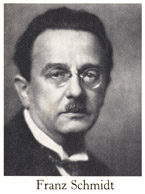

Dr.
Volkmar Andreae, Conductor.
Picture taken from Masterseal LP MW 40 with Anton
Bruckner's Symphony No. 1.
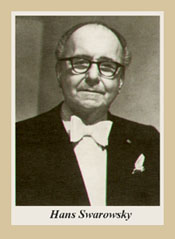
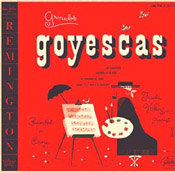
Enrique
Granados: Goyescas on R-199-116
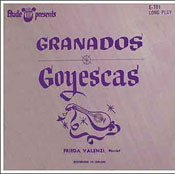
Enrique
Granados: Goyescas on another of Don Gabor's inventions - the Etude label.

Program
of the concert of April 4, 1960 in Porto, Portugal, with Frieda Valenzi performing
with the Orquestra Sinfonica do Conservatorio de Musica do Porto conducted
by Maestro Silva Pereira.

Schumann's
"Fantasie" coupled with Brahms' "Schumann Variations" played by Frieda Valenzi
as released on Merit Records, reference number M200-28

The
cover of the early release of the 10" Remington with Frieda Valenzi's interpretation
of Ravel's "Le tombeau de Couperin".


Frieda Valenzi's
Symphonic Variations on the Australian Festival label.


|
Frieda Valenzi
made her debut in Vienna in the great and famous Musikvereinssaal performing
Piano Concerto in A minor, Op. 16, of Edward Grieg. That was around 1930.
Throughout
her career she made extensive concert tours in Germany, Italy, Portugal, Canada,
USA, and Mexico and she even traveled to Mozambique. Her vast repertory extends
far beyond the great works of the classic and romantic periods.
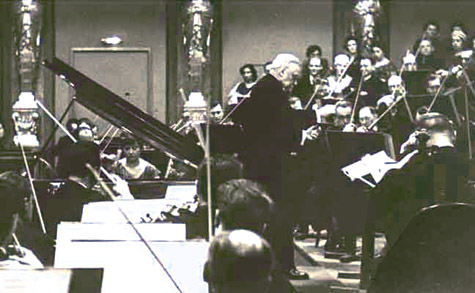
Performing
Brahms' 2nd Concerto with conductor Volkmar Andreae in the Grosse Musikvereinssaal
in Vienna  Frieda
Valenzi was born on May 15, 1910 in Vienna. She studied at the "Viennese State
Academy for Music and Dramatic Art", theory with composer Joseph Marx and
cellist/composer Franz Schmidt, and piano with Walter Kerschbaumer and Friedrich
Wührer. Frieda
Valenzi was born on May 15, 1910 in Vienna. She studied at the "Viennese State
Academy for Music and Dramatic Art", theory with composer Joseph Marx and
cellist/composer Franz Schmidt, and piano with Walter Kerschbaumer and Friedrich
Wührer.
Already in the years before the 2nd World War she was a teacher herself at that
same academy and resumed teaching in 1950 (meanwhile the institute's name had
been changed to simply "Academy for Music and Dramatic Art", currently 'Universität
für Musik und Darstellende Kunst').
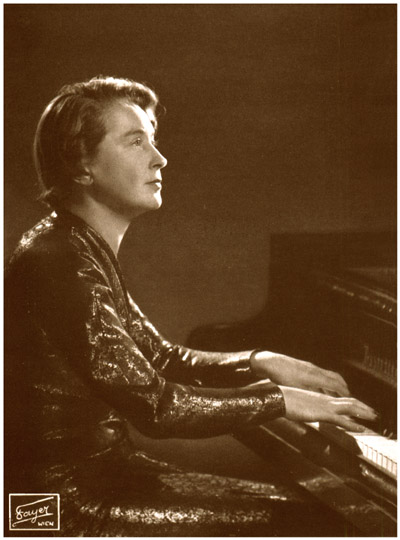
Frieda
Valenzi early in her career. (Photo by Fayer, Vienna). First
she taught in the conducting class next to Hans Swarowsky. In 1959 she received
the title of professor and from 1970 on she taught concert performing. This position
she held until 1980 when she officially became a pensioner. However she continued
to work for another 2 years but had to stop when she had a stroke which paralyzed
her at one side and made it impossible to continue teaching and performing.
Each
summer, from 1964 until 1972, Mrs. Valenzi conducted courses in interpretation
in the "Centre Culturel du Luxembourg" in Saint Hubert en Ardennes
in Belgium. She judicated in many competitions like the "Concours de Genève"
and the "Leipziger Bachwettbewerb". As
a pianist she always had a strong affinity for the works of the modern composers
and her list of performances of the contemporary piano literature is enormous.
Young students may find names and works which may rise their curiosity and inspire
them to explore more modern composers. The real meaning of Frieda Valenzi's art
does not solely stem from her Remington recordings - though fortunately they are
there to witness her insights in the performance of important compositions from
the piano literature - but lies merely in the fact that she brought a great variety
of new music to the many audiences that came to listen to her concerts and recitals,
or listened to her many radio recordings for ORF (Austrian Broadcasting Authority)
in Vienna:
Hans-Erich
Apostel:
Piano concerto Op. 30;
Bela Bartok: Sonatine for piano on peasant themes;
Friedrich Bayer: Piano concerto;
Alban Berg: Chamber Concerto for Violin, Piano and 13 wind instruments,
Piano sonata Op. 1;
Boris Blacher: Variations on a Theme of Muzio Clementi;
Arthur Bornschein: Arabesques for piano and orchestra;
Johannes Brahms: Piano sonata No. 3, Piano concerto No. 2, Piano pieces
Op. 118;
Thomas Christian David: Piano concerto;
Claude Debussy: 12 Etudes Book I, 12 Etudes Book II;
Antonin Dvorak: Six silhouettes for piano Op. 8 Book II;
Werner Egk: Piano sonata;
Lukas Foss: Concerto No. 2;
Jean Françaix: Cinq portraits de jeunes filles;
César Franck: Prélude, chorale et fugue;
Enrique Granados: Goyescas, Suite No. 1;
Hans Hagen: Concerto piccolo for piano, orchestra and jazz band, Scherzo
for piano and orchestra, Toccata ciocosa for piano and orchestra;
Christobal Halffter: Portuguese Rhapsody for piano and orchestra;
Karl Amadeus
Hartmann: Concerto for Wind Instruments, Piano and Percussion;
Paul Hindemith: Kammermusik No. 2;
Wilhelm Hübner: Piano concerto No. 1;
Ernst Krenek: Piano Concerto No. 2;
Witold (Withold) Lutoslawski: 5 Dance-preludes;
Bruno Maderna: Concerto;
Frank Martin: Ballade (1939), Concerto (1933-4);
 Joseph
Marx: Castelli Romani; Joseph
Marx: Castelli Romani;
Karl Franz Müller: Concerto en miniature No. 1;
Alois Pachernegg: Concertino for piano and strings, Prologue for piano
and orchestra;
Hans Pfitzner: Pieces Op. 47;
Sergei Prokofiev: Concerto No. 3; Five melodies;
Albert Roussel: Piano Concerto;
Arnold Schönberg: Piano Concerto Op. 42, Three pieces Op. 11, Six
small pieces Op. 19, Five pieces Op. 23, Suite for piano Op. 25;
Robert Schumann: Fantasy;
Alexander Scriabin: Preludes Op. 11;
Dimitri Shostakovich: 24 Preludes and fugues;
Oscar Strauss: Piano concerto;
Igor Stravinksy: Concerto for Piano and Wind Instruments;
Peter Tchaikovsky: Andante and finale for piano and orchestra Op. 7, The
Seasons Op. 37a;
Erich Urbanner: Piano Concerto;
Francesco Valdambrini: Dialogues for Piano and Sections of the Orchestra;
Roger Vuatas:
Piano concerto Op. 112; Wolf-Ferrari: Sonatine in E, Sonatine in c;
Heinz Walberg:
"Konzert für die Einzige" for piano and orchestra.
| Numerous
compositions from the new piano literature had their first performance by Frieda
Valenzi. Many composers dedicated compositions to her. And her performance of
the Complete Piano Compositions of the Viennese School is considered stylistically
as exemplary. She
also recorded for radio broadcasts with RAI in Rome. Regrettably she did not make
many LP recordings. The recordings for the Remington label were made in 1951 and
1952.
There is an LP recording of Müller's "Concerto en miniature No.1"
which dates from the nineteen seventies in which she is the soloist. The conductor
is Christoph Michael. (Preiser 9907). 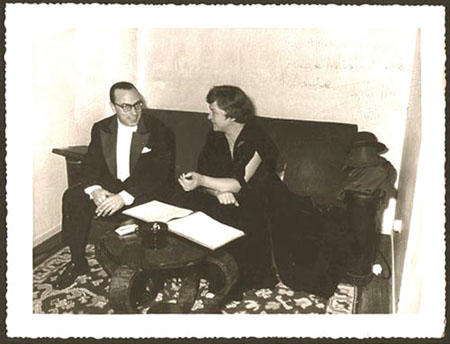
Frieda Valenzi with her favorite conductor Joaquim
da Silva Pereira from Portugal. The photograph was taken in the artists' room
of the Conservatory in Porto and was given to Mrs. Valenzi in Vienna. It
bears the dedication: "Pour Frieda Valenzi - Grande artiste et chère Amie
- Silva Pereira - Wien 1968"
Mrs. Frieda Valenzi in 1960 with Portuguese conductor
Joaquim da Silva Pareira. Frieda
Valenzi was above all a soloist and loved to concertize. She performed with international
acclaimed conductors, but her favorite conductor was Joaquim da Silva Pereira
from Portugal. When
she was asked she also accompanied other instrumentalists. The Sonata for Violin
and Piano of César Franck always was one of her favorites.
In 1968
Mrs. Valenzi was honored with the "Austrian Cross of Honor for Science and Art"
and in 1981 she received the "Gold Cross of Honor for merits on behalf of the
Republic of Austria". She
had several outstanding students. Among those French pianist Alain Balageas and
Austrian Alexis Hauser now a conductor.
Alexis Hauser remembers Mrs. Frieda Valenzi:
"She is one of the greatest
teachers I have ever had, and the only one who significantly helped me on the
piano. If I only would have had her marvelous instructions sooner in my musical
upbringing. It is now more than thirty years ago, but I remember her class as
if it were yesterday. She was definitely a born pedagogue because she knew exactly
how to bring the best out in her students!" - Alexis Hauser
| At
one time, conductor Mrs. Roswitha Heintze, once also a pupil of Frieda Valenzi,
had the honor to conduct when Frieda Valenzi was the soloist in Rachmaninoff's
2nd Concerto in C minor, Op. 18. Before the intermission Bedrich Smetena's symphonic
poem "The Moldau" (Vltava) was on the program. Just before the concert was to
start the triangle player had been reported ill. Mrs. Valenzi volunteered and
replaced him, however with great problems because of the long silences in the
score for the triangle. So she just played it by ear! Mrs. Heintze said: "We still
laugh about this event today and were very happy when we read in Richard Strauss's
"Memories" about a similar happening when in the "Academische Festouverture"
Richard Strauss was to play the drum and Hans von Bülow the cymbal all to
the honor of Johannes Brahms. But time after time both lost measure and had to
ask the trumpet player to redirect them in the score." To
the occasion of Frieda Valenzi's 90th birthday on May 15, 2000, Richard Strauss's
Sonata, Brahms's Sonata in F and "Goyoh" ("Stillness") by Hae-Sung Lee, in its
first performance, were played at the "University for Music and the Performing
Arts" (as the institute is called nowadays). Performers were cellist Alexander
Baillie (a pupil of Jaqueline du Pre) and Roswitha Heintze at the piano.
Despite her handicap, Frieda Valenzi is in close contact with music and performance.
She attends as often as possible classes and performances at the University in
Vienna. The
Remington recordings of Frieda Valenzi: R-149-17
Maurice Ravel: Le tombeau de Couperin (released early 1951). R-149-51
César Franck: Variations symphoniques (coupled with Debussy: Prélude
à l'après-midi d'un faun) with conductor Jean Moreau (released in
March 1952). Recorded Saturday, January 26, 1952 in the Brahms-Saal. R-199-116
Enrique Granados: Goyescas. Don Gabor released Frieda Valenzi's 'Goyescas'
recording on his Etude label in 1952 with reference E-701 before
it was issued on Remington R-199-116 in 1953.
Four
of the seven pieces from "Goyescas" played by Frieda Valenzi on Remington R-199-116
were recorded in 1951. Her recording was for a long time the only LP recording
of the work available in the USA until the Spring of 1954 when the recording of
José Falgarona (VOX PL 8580) was released. 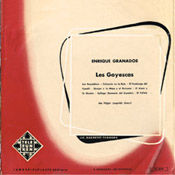 The
following year the complete recording of the 7 pieces played by Spanish pianist
Leopoldo Querol (Leopold Querol) became available in France on Ducretet-Tomson
LPG 8681, in Spain, and in Germany on Telefunken LE 6528, but not in the USA. The
following year the complete recording of the 7 pieces played by Spanish pianist
Leopoldo Querol (Leopold Querol) became available in France on Ducretet-Tomson
LPG 8681, in Spain, and in Germany on Telefunken LE 6528, but not in the USA.
A
recording of Soriano Gonzales performing Goyescas had
been made around 1954 but was not available outside Spain and
France. Then there was the recording by Cuban pianist José
Echaniz on Westminster 5322. (José Echaniz was also
a conductor. He conducted the Grand Rapids Symphony Orchestra
from 1948–1954.) Around the same time Russian-Georgian
Nikita Magaloff made his early recording issued in the US
on London LL 954 in 1955. It had already been released one year
earlier on English Decca LXT 2900. A recording by Amparo
Iturbi followed in 1956 (RCA LM1925).
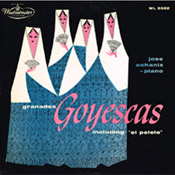 Mrs.
Valenzi's edition suffered from inferior manufacturing of plates
and pressings, and during the recording there was generally
no time for making more than one take. The recording would only
be interrupted when a significant error occurred. So there was
practically no splicing facility. And then the recording, like
any recording, could have been done on any Monday afternoon,
and possibly was made in a hurry and most probably she had to
be ready on short notice.)* Mrs.
Valenzi's edition suffered from inferior manufacturing of plates
and pressings, and during the recording there was generally
no time for making more than one take. The recording would only
be interrupted when a significant error occurred. So there was
practically no splicing facility. And then the recording, like
any recording, could have been done on any Monday afternoon,
and possibly was made in a hurry and most probably she had to
be ready on short notice.)*
 Pierre
Boulez once said in an interview on television that, if you
have seen a painting, it is easier to start painting yourself
and you may even emulate the original. But being the first human
being to make a painting is an entirely different matter. It
is clear that Mrs. Valenzi was pioneering the complexity of
the score as was Leopoldo Querol who recorded also in
those early 1950s and also his recording was hardly spliced. Pierre
Boulez once said in an interview on television that, if you
have seen a painting, it is easier to start painting yourself
and you may even emulate the original. But being the first human
being to make a painting is an entirely different matter. It
is clear that Mrs. Valenzi was pioneering the complexity of
the score as was Leopoldo Querol who recorded also in
those early 1950s and also his recording was hardly spliced.
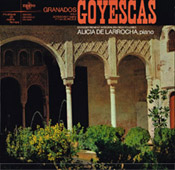 Although
the performance of Eduardo del Pueyo (himself from Spain and of course
a compatriot of Granados) was released much later on the Philips label (1957)
and received acclaim, it was Alicia de Larrocha's first recording in 1956 for
Hispavox (released in the US on American Decca and on Brunswick in Great Britain)
that more or less set the standard. Of course talent is needed. And since we all
remember Alicia de Larrocha's second recording on Erato/Hispavox from the
nineteen sixties, followed by her RCA and Decca recordings, and the recordings
by Thomas Rajna (CRD) and Rena Kyriakou (VOX/Turnabout), it is easy
to find faults in the recordings made in the very early nineteen fifties. Although
the performance of Eduardo del Pueyo (himself from Spain and of course
a compatriot of Granados) was released much later on the Philips label (1957)
and received acclaim, it was Alicia de Larrocha's first recording in 1956 for
Hispavox (released in the US on American Decca and on Brunswick in Great Britain)
that more or less set the standard. Of course talent is needed. And since we all
remember Alicia de Larrocha's second recording on Erato/Hispavox from the
nineteen sixties, followed by her RCA and Decca recordings, and the recordings
by Thomas Rajna (CRD) and Rena Kyriakou (VOX/Turnabout), it is easy
to find faults in the recordings made in the very early nineteen fifties.
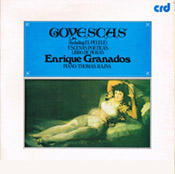 It
is true, in olden days many works had to be pioneered by performing
artists when there were - except for the works of Bach, Mozart,
Beethoven, Brahms, Schubert, Schumann and Chopin - practically
no examples available on record of compositions that did not
belong to the so-called 'iron repertory'. 'Goyescas' is a perfect
example of this fact as most pianists may initially have found
difficulty in finding the structure in the complexity as indicated
by the composer himself. Even today where there are so many
historic performances available, protagonists of the younger
generation do not always understand the nature of, say the Grieg
Concerto, which is so obvious if they would have made a study
of 'Grieg in his time' and taken his Norwegian roots
and Norwegian folk music into account.- R.A.B. It
is true, in olden days many works had to be pioneered by performing
artists when there were - except for the works of Bach, Mozart,
Beethoven, Brahms, Schubert, Schumann and Chopin - practically
no examples available on record of compositions that did not
belong to the so-called 'iron repertory'. 'Goyescas' is a perfect
example of this fact as most pianists may initially have found
difficulty in finding the structure in the complexity as indicated
by the composer himself. Even today where there are so many
historic performances available, protagonists of the younger
generation do not always understand the nature of, say the Grieg
Concerto, which is so obvious if they would have made a study
of 'Grieg in his time' and taken his Norwegian roots
and Norwegian folk music into account.- R.A.B.
|
It
was financially very attractive to make recordings in Europe right after World
War II and many artists were happy to earn a living right after the war in devastated
Europe. They sometimes did not care much about the quality of a specific recording
and irregularities were tolerated at the time.
Hearing Valenzi's performance
in this perspective, the nature of her interpretation has more sense and although
it leans at times slightly towards the classics, there are some poetical and moving
moments in the Remington recording. There
is also another aspect which is easily forgotten and that is the significance
of the equalization curve which was used by the cutting engineer. In 1951 the
RIAA curve was not the standard. Only equipment used at the time or high quality
playback equipment of today do reveal the inner core of many an old recording.
Those who have equipment with adjustable equalization will experience the full
impact of such old recordings. Compared to both del Pueyo's and Valenzi's, the
interpretation of Jose Echaniz on Westminster (who recorded a complete set of
pieces) has somewhat less passion and fire, and it lacks structure.)* There
is also a recording of Schumann's "Fantasie" coupled with "Schumann
Variations" by Brahms, played by Frieda Valenzi and released on Merit Records,
reference number M200-28. The back of the cover says: Copyright 1952 and
on the front cover it is mentioned that the performer as being "v. frieda, pianist".
In
Vienna after the recording was made, a technician or an assistent wrote on the
label of the container with the tape "v. Frieda" to indicate "Valenzi
Frieda" meaning that the artist's name should not be confused with any other
Valenzi. Yet many collectors and dealers started to phantasize about the artist's
name and wrongly attributed these performances to  Etelka Freund. The
Plymouth release of these same performances has reference number P-12-28.
Etelka Freund. The
Plymouth release of these same performances has reference number P-12-28.
There
exists no release of Frieda Valenzi's Schumann and Brahms performances on Remington
because Edward Kilenyi played the same works for the Remington label, the recording
by Frieda Valenzi was only released on Merit and Plymouth. The same goes for the
Ravel disc with 'Le tombeau de Couperin'. As
Don Gabor mostly just bought the recorded performances, produced in Vienna by
Marcel Prawy, most artists never met him.
| |
R-149-51
with the wonderful interpretation of César Franck's "Variations symphoniques"
by Frieda Valenzi with the Austrian Symphony Orchestra. |
| In
Australia Frieda Valenzi's performance was released on the Festival label. It
is probable that Festival had a license agreement with Concerteum from France. |
|
| |
In
France the recording was released on the Concerteum label, reference TCR 272. |
| The
performance of 'Variations symphoniques' by pianist Alexander Brailowsky and conductor
Jean Paul Morel (coupled with Liszt's 'Danse macabre' with Fritz Reiner conducting)
confirms that the conductor in the Remington recording with Frieda Valenzi is
indeed Jean Paul Morel. At right the French VDSM FALP 172 release of Brailowsky's
Franck which is the equivalent of RCA LM 1195, released in the Spring of 1952.
Brailowsky got a good note from Warren DeMotte while the Remington disc was not
mentioned. | |
| |
In
France there was a release on the Odeon label of Symphony in D of César
Franck coupled with "Variations symphoniques" with conductor Hans Swarowsky.
The name of the pianist as printed on label and cover is Eva Vollma. Listening
to this performance and comparing the performance of Frieda Valenzi on Remington,
there are similarities in style that suggest that Eva Vollma is in fact Frieda
Valenzi, although the Swarowsky recording misses the atmosphere of the Remington
/Concerteum performance. |
As
so many music listeners I have been an admirer of César Franck's Symphonic
Variations, his Violin Sonata, and the Symphony in D. And my interest was heightened
when Dutch organist Sjoerd Mook (from Doetinchem) explained the works of César
Franck to me many years ago. Of the Symphonic Variations I have owned the recording
of Leon Fleisher and George Szell. There is also the exquisite performance by
Walter Gieseking with Sir Henry Wood on 78 RPM Columbia; the passionate performance
by Maria Grinberg; the clean Alexis Weissenberg; the at times lethargic Moura
Lympany with Walter Susskind; the idiomatic French Jean Doyen with Jean Fournet
conducting, and many more pianists.
But
when I heard the Remington recording of Frieda Valenzi with conductor Jean Moreau,
I sat at the edge of my seat and was completely absorbed by the performance. For
the first time in my life I heard that "Variations symphoniques" are really variations
for piano and orchestra. The interpretation on Remington R-149-51 (in France Concerteum
TCR 273) shows clearly the different variations and the groups of variations in
the score. Frieda Valenzi has the perfect phrasing and conductor Jean Moreau is
a worthy accompanist who has the same excellent timing; he reminded me of Wilhelm
Furtwängler at certain instances. Moreau's
talent is typically evident in Debussy's "Prélude à l'après-midi
d'un faun" on Side Two. Debussy is telling, moving, inspiring. Despite a few mistakes
in Franck's Variations, made by the pianist on the spur of the moment - bear in
mind that the recording was most certainly done in one take and there was no splicing!
- both performances never fail to compell. It is a recording that should be high
on the want-list of collectors of music for piano and orchestra. Frieda Valenzi
plays with passion and compassion. Conductor Jean Moreau is without doubt Jean
(Paul) Morel who, in the nineteen forties and early fifties was a colleague of
conductor Laszlo Halasz at the New York City Opera Company. Jean
Paul Morel was an excellent accompanist and interpreter. His recordings are rare
and cherished by collectors. - R.A.B.
|
| |
Click here
for a Sound Clip of Variations Symphoniques of César Franck played
by Frieda Valenzi and conductor Jean Moreau (Morel). |
|
Text written by Rudolf A. Bruil. Page first published in February, 2001
On February
5, 2002, Mrs. Frieda Valenzi died in Vienna at the age of 91. She will be remembered
as an artist who dedicated her life to the promotion of works of modern composers.
And she will be remembered by her many pupils as an influential teacher.
)* Interesting reading
in this respect can be found in the July/August 2004 issue of "International
Piano" (Orpheus Publications, London), in which author-pianist Charles Hopkins
gives an analysis of the history and nature of "Goyescas" and the earliest
interpretations by various pianists. |

